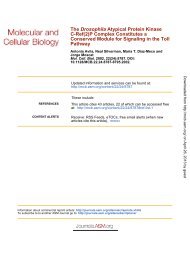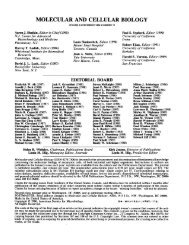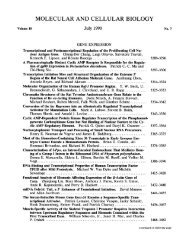Distinct Cellular Functions of MK2 - Molecular and Cellular Biology ...
Distinct Cellular Functions of MK2 - Molecular and Cellular Biology ...
Distinct Cellular Functions of MK2 - Molecular and Cellular Biology ...
You also want an ePaper? Increase the reach of your titles
YUMPU automatically turns print PDFs into web optimized ePapers that Google loves.
VOL. 22, 2002 RESCUE OF <strong>MK2</strong>-DEFICIENT CELLS 4833<br />
FIG. 4. Catalytic activity <strong>and</strong> the proline-rich N-terminal region <strong>of</strong> <strong>MK2</strong> are necessary for rescue <strong>of</strong> cell migration. (A) Different N-terminal<br />
proline-rich motif mutants (myc-<strong>MK2</strong>-CT1-AA <strong>and</strong> myc-<strong>MK2</strong>-CT1-�P) used in the migration rescue experiment. The core <strong>of</strong> the proline-rich<br />
motif <strong>and</strong> the mutuated residues are shown in boldface. (B) Control <strong>of</strong> Myc-tagged protein expression from the different constructs transfected<br />
into HEK293 cells by Western blotting. (C) <strong>MK2</strong> kinase assay <strong>of</strong> lysates from transfected <strong>MK2</strong>-deficient MEFs before (�) <strong>and</strong> after (�) stress<br />
stimulation using recombinant Hsp25 as the substrate. (D) Migration <strong>of</strong> the transfected MEFs through fibronectin-coated membranes (absolute<br />
values <strong>of</strong> migrated cells when 30,000 cells were assayed in a well <strong>of</strong> 8 mm 2 ). Error bars indicate the st<strong>and</strong>ard deviations from three independent<br />
experiments.<br />
monitored in parallel transfections <strong>of</strong> HEK293 cells <strong>and</strong> antimyc<br />
Western blotting (Fig. 4B). Different mutants were expressed<br />
at levels comparable to that <strong>of</strong> wild-type <strong>MK2</strong> (Fig. 4B,<br />
CT1). Catalytic activity in transfected <strong>MK2</strong>-deficient MEFs,<br />
resting <strong>and</strong> stress stimulated, was determined by kinase assays<br />
with recombinant Hsp25 as the substrate. As expected,<br />
CT1-KR did not exhibit catalytic activity. In contrast, similar<br />
levels <strong>of</strong> stress-inducible catalytic activity for both the N-terminal<br />
mutants <strong>and</strong> the wild-type construct were detected (Fig.<br />
4C). Remarkably, only the full-length catalytically active kinase<br />
was able to rescue the migration defect (Fig. 4D). This is in<br />
contrast to the LPS-induced production <strong>of</strong> TNF in macrophages,<br />
where catalytic activity provided by the catalytic domain<br />
alone is sufficient to restore TNF production. These re-<br />
sults show that catalytic activity in combination with the <strong>MK2</strong><br />
N terminus is required for cellular migration.<br />
DISCUSSION<br />
Elimination <strong>of</strong> the stress-activated protein kinase <strong>MK2</strong> results<br />
in a complex phenotype represented by decreased p38<br />
MAPK levels in most tissues analyzed, especially in heart <strong>and</strong><br />
liver, <strong>and</strong> by a decrease in the biosynthesis <strong>of</strong> several proinflammatory<br />
cytokines at the posttranscriptional level in mouse<br />
macrophages (9). In addition, impaired filopodium formation<br />
in growth factor-stimulated macrophages <strong>and</strong> altered migration<br />
<strong>of</strong> embryonic fibroblasts <strong>and</strong> smooth muscle cells were<br />
observed. By introducing full-length <strong>and</strong> mutant forms <strong>of</strong> <strong>MK2</strong><br />
Downloaded from<br />
http://mcb.asm.org/<br />
on January 31, 2013 by guest







